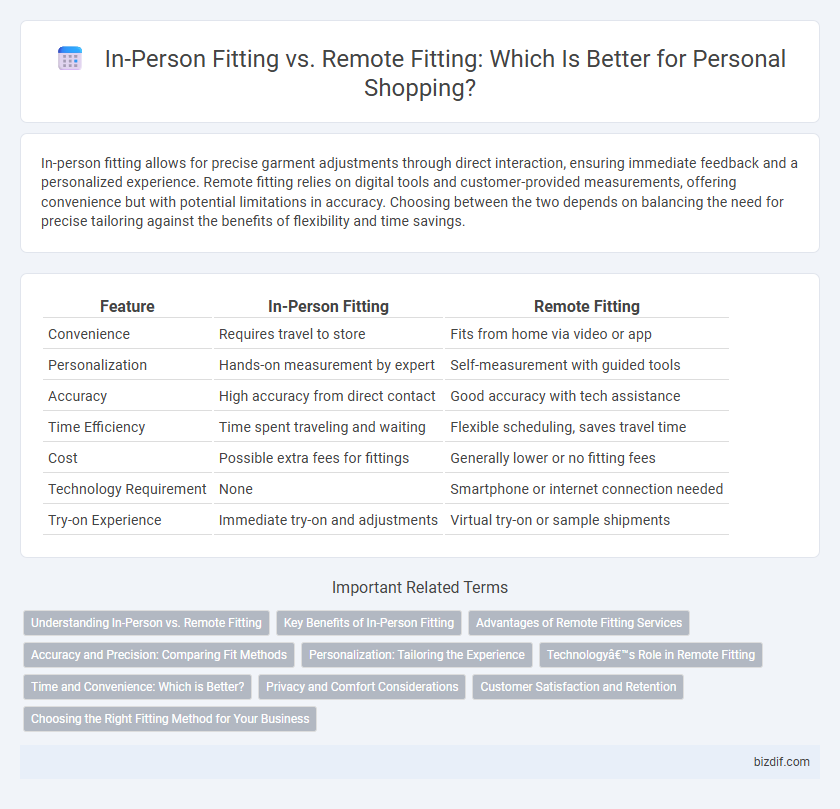In-person fitting allows for precise garment adjustments through direct interaction, ensuring immediate feedback and a personalized experience. Remote fitting relies on digital tools and customer-provided measurements, offering convenience but with potential limitations in accuracy. Choosing between the two depends on balancing the need for precise tailoring against the benefits of flexibility and time savings.
Table of Comparison
| Feature | In-Person Fitting | Remote Fitting |
|---|---|---|
| Convenience | Requires travel to store | Fits from home via video or app |
| Personalization | Hands-on measurement by expert | Self-measurement with guided tools |
| Accuracy | High accuracy from direct contact | Good accuracy with tech assistance |
| Time Efficiency | Time spent traveling and waiting | Flexible scheduling, saves travel time |
| Cost | Possible extra fees for fittings | Generally lower or no fitting fees |
| Technology Requirement | None | Smartphone or internet connection needed |
| Try-on Experience | Immediate try-on and adjustments | Virtual try-on or sample shipments |
Understanding In-Person vs. Remote Fitting
In-person fitting allows for direct, tactile evaluation of clothing with immediate adjustments and personalized feedback, enhancing accuracy in size and comfort. Remote fitting relies on virtual tools and customer-provided measurements, offering convenience and access to broader options but may face challenges in fit precision. Understanding these differences helps consumers choose the best fitting method based on their needs for immediacy, accuracy, and adaptability.
Key Benefits of In-Person Fitting
In-person fitting provides precise measurements through direct interaction, ensuring tailored clothing that fits perfectly and enhances comfort. It allows immediate adjustments and personalized style advice from experienced professionals, boosting confidence in the final purchase. The physical experience of trying on garments helps customers assess fabric, fit, and overall look more accurately than remote methods.
Advantages of Remote Fitting Services
Remote fitting services offer unparalleled convenience by eliminating the need for travel and providing personalized measurements from the comfort of home. Advanced technologies, such as virtual try-ons and 3D body scanning, enhance accuracy and ensure a tailored shopping experience. This approach expands access to expert fittings regardless of geographical location, making high-quality personal shopping more inclusive and efficient.
Accuracy and Precision: Comparing Fit Methods
In-person fitting offers unparalleled accuracy and precision through direct measurements and real-time adjustments, ensuring garments fit perfectly to individual body shapes. Remote fitting relies on digital tools and self-measurements, which may introduce variances due to subjective input and technology limitations. The choice between fit methods significantly impacts the final product's tailoring quality, with in-person fittings generally delivering superior results.
Personalization: Tailoring the Experience
In-person fitting offers unparalleled personalization by allowing shoppers to receive real-time feedback and adjustments from expert stylists, ensuring precise measurements and a perfect fit. Remote fitting leverages advanced technology such as virtual try-ons and AI-driven size recommendations, enabling a tailored experience without the need for physical presence. Both methods prioritize individual preferences and body metrics, enhancing the shopping journey through customized solutions.
Technology’s Role in Remote Fitting
Remote fitting leverages advanced technologies such as 3D body scanning, augmented reality (AR), and artificial intelligence (AI) to create precise virtual measurements and enhance garment customization. These technological innovations enable shoppers to experience personalized fittings from the comfort of their homes, reducing the need for in-person visits. The integration of smart apps and real-time feedback systems ensures accurate size recommendations and improves overall satisfaction in personal shopping experiences.
Time and Convenience: Which is Better?
In-person fitting offers immediate, hands-on adjustments and personalized advice, saving time during the shopping process by addressing concerns on the spot. Remote fitting provides convenience by allowing customers to try products at home without travel, though it may require multiple exchanges or returns, potentially extending the overall timeline. Choosing between them depends on whether the priority is instant feedback and perfect fit or flexible timing and comfort.
Privacy and Comfort Considerations
In-person fitting ensures complete privacy as customers interact directly in a controlled environment, minimizing data exposure compared to remote fitting technologies that rely on digital platforms. Remote fitting offers convenience but raises concerns about data security and personal comfort due to potential surveillance and improper sizing measurements. Prioritizing privacy and comfort, in-person fittings remain the preferred choice for sensitive personal shopping experiences.
Customer Satisfaction and Retention
In-person fitting enhances customer satisfaction by providing immediate, personalized adjustments and a tactile shopping experience that fosters trust and confidence in product choices. Remote fitting leverages technology to offer convenience and accessibility, appealing to customers who value time savings and flexibility, which can increase retention through consistent follow-ups and easy return policies. Both methods impact customer loyalty differently, with in-person fitting driving deeper emotional connections, while remote fitting excels in maintaining engagement through digital integration.
Choosing the Right Fitting Method for Your Business
In-person fitting offers personalized, hands-on service that builds trust and enhances customer satisfaction through direct interaction and immediate adjustments. Remote fitting leverages technology such as virtual measurements and 3D modeling to expand reach and convenience for customers who cannot visit physically. Selecting the right method depends on your business model, target audience, and resources, balancing personalized experience with accessibility and scalability.
In-person fitting vs Remote fitting Infographic

 bizdif.com
bizdif.com